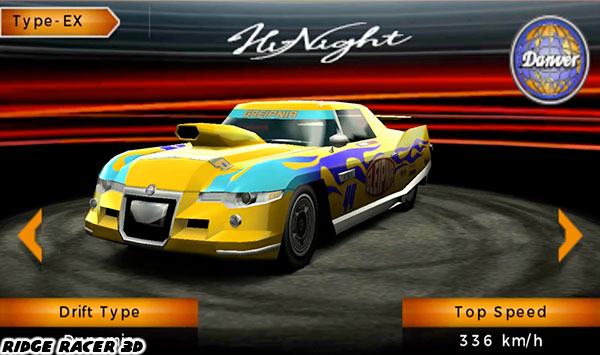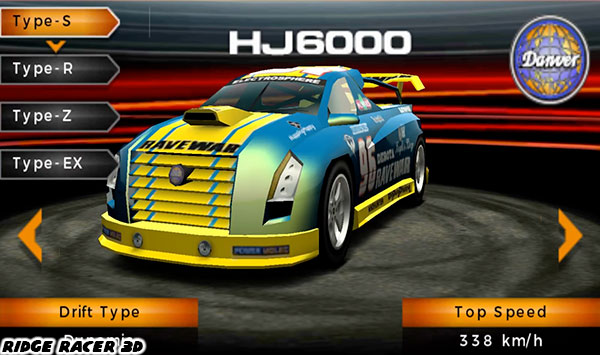Since its inception in 1993 all the way to the most recent release at the end of 2013 Ridge Racer had become the longest-running arcade racing series ever created. Despite the lack of actual manufacturers it was nonetheless a celebration of car culture. The Japanese designers were very much aware of the trends as well as the history of the automotive history. When they had a chance to present idealized, and equally outlandish Western-themed cars they did. Very early on in the series I mentioned that post WWII the USA auto industry grew at an exponential rate. The soldiers returning from war found suburban life much to their liking. These Baby Boomers were looking to buy their first new cars. They had to have more style and performance abilities than the previous generation. Many auto manufacturers looked to the "jet age" school of design. They added fins and sharp angles to the lines of the car. Many of these design elements were ornamental rather than functional but it didn't matter. The cars looked cool and nothing at all like the rounded bodies and bulky frames from earlier models. Just because many of the post-war family cars were big did not mean they were slow either. People from the US demanded more power and they got it on every ride.

Namco created a fictional western manufacturer that represented the excesses of size and power. They named the company Danver and used it as a launch pad for some radical designs. Many of which were a nod to the cars that defined classic Americana. The Spectra for example looked like a chopped and stretched "hot rod" version of a classic Cadillac. It was absolutely massive. Much bigger than most of the cars in the Ridge Racer series the Spectra was expected to perform like a slug on the track. Of course looks could be deceiving. The Spectra was actually an elite level car. At top speed with nitro boost it was able to hang with the much stealthier Devil 13 or lightweight Angel 0.

Fans of the series learned early on that realistic physics went out the window when Ridge Racer was concerned. It was the lack of realistic physics that originally made me a skeptic of the series. The game was actually designed to be experienced from two different gameplay perspectives. The "Grip" type cars were expected to be driven like those in traditional simulation racing games. Drivers would have to find the optimal places to brake and accelerate through turns. Drifting a little would kill their momentum and hurt their lap times. Then there were the "Drift" type cars which could enter turns going much faster, slide around corners and exit while maintaining their momentum. The various releases of Ridge Racer both in the arcade and at home experimented with the Grip and Drift type cars. The more recent games allowed audiences to swap out engines, change body kits, and find the balance that worked best for their own particular style of driving. Of course the game was balanced heavily in favor of drift type cars.

It was up to the developers to create the most memorable drift machines ever featured in a racing series. Some of those rides, like the Spectra were absurd but also extremely fun to drive in. The Japanese designers were aware at how much people in the USA lived in excess. It was much more than their impression based on the media or even from the occasional visit overseas. People in the USA just seemed to be bigger in every regard. They were taller and fatter than those from other nations. They ate big meals, watched TV on gigantic screens and celebrated the size of their homestead. The most important thing that Namco developers picked up on was how much the West loved big cars. Near everyone on the road seemed to have an SUV if not a truck. This realization was reflected with the Danver Bass Cruiser.

The Bass Cruiser could hold its own against the svelte European race cars and it could also hold six passengers in the process. The car was equipped with three television sets and an enormous sound system. The speakers were probably some sort of secret propulsion source. It would be the only thing that could explain how a car so large and bulky could have moved so quickly. The Danver company
had a truck that was equally massive called the Hijack. When the two bruisers were on the road together there was little chance for the smaller cars to get around them. The only thing that stood a chance against them was a secretive sedan that was made by an unknown manufacturer.
The Monstrous was inspired by the car featured in the Men in Black film. Its bulky frame, about the size of a presidential limo, was a facade for some secret technology. Like the Spectra before it the car was capable of some amazing feats. It was also difficult to control and provided a suitable challenge for the most dedicated racing fans to master.
The Japanese developers were pandering to the Western audience and it was fine by us. Where their designs really shined however were not with the bulky land yachts. The muscle car era may have died in the '70s but in the Ridge Racer series it was very much alive and well. The next blog will show how much the Japanese designers could teach us about an era the US let go.
If you would like to sponsor me
please visit my Patreon page and consider donating each month, even as little as $1 would help make better blogs and even podcasts!



No comments:
Post a Comment